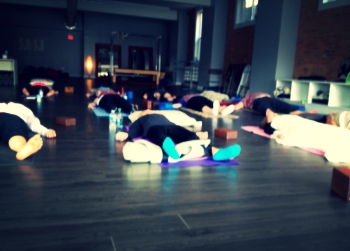 While traveling a few years ago, I attended a yoga class that left me puzzled. The instructor taught a challenging sequence full of interesting and creative movements.
While traveling a few years ago, I attended a yoga class that left me puzzled. The instructor taught a challenging sequence full of interesting and creative movements.
It was fun, the teacher was inspiring and I was on my way to having one of the most fulfilling practices I had ever had while on the road....until savasana.
When it came time to finally let go at the end of class, he dimmed the lights, did a relaxation exercise, played a song followed by a chant. Next he read a passage from a book, repeated it twice and brought us back to sitting. I walked away feeling ungrounded and exhausted. After the class, my friend who was along for the ride turned to me and said "what did you think of that corpse pose?"
I replied "I wish he had just let me die".
The Importance of Savasana
Savasana is meant to be the moment of letting go in the yoga practice. Some teachers avoid speaking of the death symbolism and prefer to call it "final relaxation". However, as far as I have learned and personally experienced, the corpse-like stillness assists our students in a profound release of the ego's holding.
For a few precious moments there is space for the student to let go of their hectic life full of goals and effort. This space prepares us all for more grace in our own lives as we are reminded that life in this body will, one day, end.
Sadly, I find that what happened during that Savasana I described is something that I experience in public classes more often than not.
How to Teach The Best Savasana Ever
While you can't control the experience of you students, you can provide a container for your students to feel the full depth of what these last few moments of class offer. If you haven't found your Savasana groove here are my recommendations:
1. Give your students at least 10 minutes of Savasana
In our express-everything world, yoga classes are getting shorter and shorter. You might feel the pressure to cram ninety minutes of class content into a one hour slot. However, in order to give your students the time and space to truly integrate their yoga asana and let go deeply, a minimum of ten minutes is essential for the general population.
2. To speak or not to speak
For a new yogi or one who is attending yoga in order to de-stress, guided Savasana or a calming piece of music for the first few minutes could be very useful. However, when I mentor yoga teachers, I find more and more of them offer little to no silence during savasana.
Those who overdo the Savasana speech, tell me they feel an the urgency to give as much as possible to their students. These well intentioned teachers know and love Savsasana so much that they are desperate for everyone to experience that same feeling.
However, in the thousands of classes I have attended most teachers are more distracting than helpful during this process. My tip, is to have at least 80% of your savasana be in total silence.
3. Point to the goal and let your students find their way
The most common reason Savasana falls flat (along with many instructor led meditations or intention setting exercises) is this; teachers give instructions that describe what they want the student to do or feel, but don't give them the space to really do it.
Instead of explaining in great detail every aspect of how to relax and let go, leave a few breadcrumbs and allow your students the space to explore Savasana in stillness and quiet.
4. Beware the added flare
What that well-meaning instructor I told you about at the beginning of this article attempted, was to set the stage for his students to have a magical Savasana experience. The music he used pointed to it, the poetic reading was designed to open us up and the chanting hoped to stir our souls.
His set up, however, took too long and had such an excess of distracting layers that it seemed impossible to actually get there.
Remember, Savasana doesn't exist to entertain either the student or the teacher. It is not a space for you to share your personal discourse. If you have a message to express, I recommend that you allot a few moments at the beginning of class or after Savasana when people are fully aware and open.
As teachers we owe it to our students to create the needed time and space in each class for the practice of Savasana. It need not be fun, fancy or full of sounds and sensations. Simply point and allow your students to follow.
Do you have a Savasana pet peeve? What are some of your favourite ways to lead your students through this practice? Share with us in the comments below and don't forget to subscribe to this blog for more teaching tips and insights.


